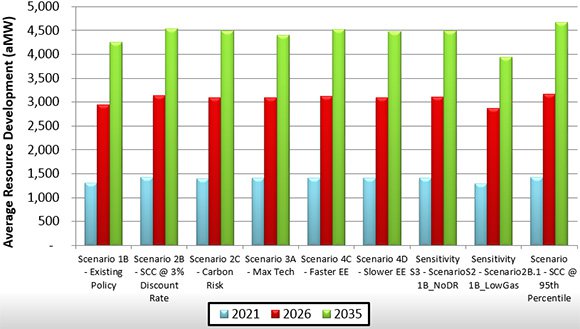Key Observations From Scenario Analysis
Regional portfolio model highlights energy efficiency and demand response as low-cost, low-risk resource options
- July 21, 2015
- Carol Winkel

At its July meeting, the Council was briefed on the latest findings from the scenario analysis used in developing its 20-year regional power plan. Here's a rundown on some key observations:
Energy efficiency appears to play a critical role in meeting both energy and winter capacity needs. Under all scenarios evaluated to date, 1,300-1,430 average megawatts are developed by 2021. It costs less than other resources, even under low electricity and gas prices. The fact that it can be "built" relatively quickly, and in the amounts needed, without fuel price and carbon risks, also make it the option chosen most often by the model.
"Efficiency acquisition isn't driven by the need for new energy," said Tom Eckman, power division director, "but because it's less expensive than operating existing resources and the surplus energy can be sold and exported outside the region at a profit."
Energy efficiency resource development

For meeting short-term peaking capacity requirements, demand response was preferred over single-cycle combustion turbines, for reasons similar to efficiency: It's the cheapest way to maintain capacity reserves; it can be built more quickly than a SCCT and in the needed amounts; it has no fuel price risk; and it doesn't add to an already surplus energy market.
While renewable resources are developed to satisfy state renewable portfolio standards, energy efficiency reduces carbon emissions at the lowest cost. And current commercially available solar and wind technologies don't provide the peaking capacity needed in the winter.
Thermal resources, while frequently optioned, are rarely constructed before 2026, except in scenarios that assume demand response resources aren't available. Energy efficiency and demand response are developed to replace the generation from already announced retiring coal plants. They meet most of the region's near-term energy and capacity needs. Eckman cautioned that these findings are limited to the need for thermal resources for peaking capacity since the Council's modeling doesn't address the need for resources to balance short-term fluctuations caused by changes in loads and renewable generation.
The next power committee webinar on the 7th power plan is scheduled for August 6 at 9:30 a.m. The next Council meeting is August 11-12 in Missoula, Montana; an additional power committee meeting has been scheduled on the 10th, 3:00 p.m. to 5:00 p.m. All meetings are open to the public.


